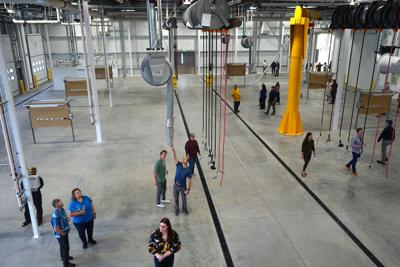The Fairbanks North Star Borough is closely monitoring federal funding for its public transit system, according to Borough Mayor Grier Hopkins.
Hopkins told the News-Miner last week that recent federal staff cuts have delayed the grants the borough receives for its MACS Transit and Van Tran services.
“It’s more a delay than a loss in revenue for our transportation department,” Hopkins said. “It’s not like it’s being looked over by DOGE, but more the staffing changeover at the FTA is slowing down the grant deliveries.”
The borough’s transportation enterprise relies heavily on Federal Transit Administration (FTA) grants to supplement fare box revenue.
“Fifty percent of that department is funded from FTA grants,” Hopkins said. “A loss or a delay in those grants means we would not be able to pay salaries for those employees.”
Hopkins has introduced an ordinance to appropriate $430,000 from the borough’s unrestricted fund balance—its savings—to help cover operational costs.
The ordinance states the $430,000 would ensure “uninterrupted operations to cover salaries, overtime, and benefits for personnel” in public transportation. It adds that “it is unknown when the operating assistance grant will become available.”
Hopkins’ recommended budget includes $4.68 million for MACS Transit and Van Tran, including FTA operations grants.
The public transportation budget includes cost increases related to personnel — due to cost-of-living adjustments, longevity pay, and benefits — as well as rising utility and fuel prices.
Hopkins also proposed boosting the Transit Enterprise Fund by $1.13 million to help offset the loss of federal COVID-19 relief funding provided through the American Rescue Plan Act of 2021. That funding expires this year, requiring the borough to return to pre-pandemic funding levels.
Rider fares and advertising only cover a small portion of the public transportation system’s operating costs. In FY 2023–2024, local revenue covered just 6% of the MACS Transit budget, and that is projected to fall to 1% in FY 2024–2025.
Hopkins’ proposed budget would increase that share to 4% while reducing reliance on federal grants from 50% to 35%. The borough also receives approximately 2% of its transit budget from state grants.
During a recent Assembly Finance Committee budget workshop, some Assembly members questioned the cost of operating MACS Transit.
Assembly member Tammie Wilson noted that the borough’s local revenue — set at $280,550 — does not come close to covering operating costs.
“It’s costing taxpayers money, over $1.2 million to operate the transit program,” Wilson said. She added that this marks a significant increase from prior years when COVID-era funding covered much of the borough’s transit expenses.
Wilson also expressed skepticism about the projected increase in ridership.
According to borough data, ridership has gradually increased since FY 2021–2022. That year saw 161,102 riders, followed by 183,262 in FY 2022–2023 and 271,287 in FY 2023–2024.
Final numbers for the current fiscal year, which ends June 30, have not been fully recorded, but the borough had only budgeted for 188,000 riders. Hopkins has increased the projected number for the upcoming fiscal year to 250,000.
Dey Johnson, the borough’s transportation manager, said the estimated 250,000 riders are based on actual usage during the 2023–2024 year. She added that data from July 1 through December 31 indicates the borough will exceed its 188,000 ridership target and likely reach the 250,000 mark.
Johnson also noted that the borough plans to overhaul how riders pay bus fare by introducing a paperless, app-based system in addition to the current monthly passes, tokens, and standard cash fare.
She said the borough is waiting on two federal grants before implementing the new fare system. Once launched, she expects it will help increase ridership.
”Primarily, we get the request from tourists or people in town short-term who may not be familiar with where our token machines are,” Johnson said.

